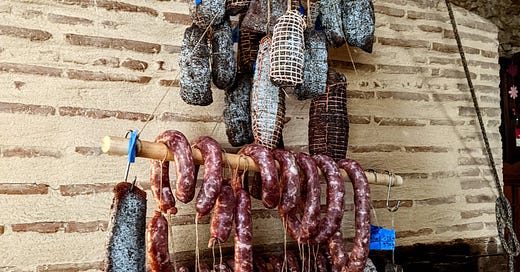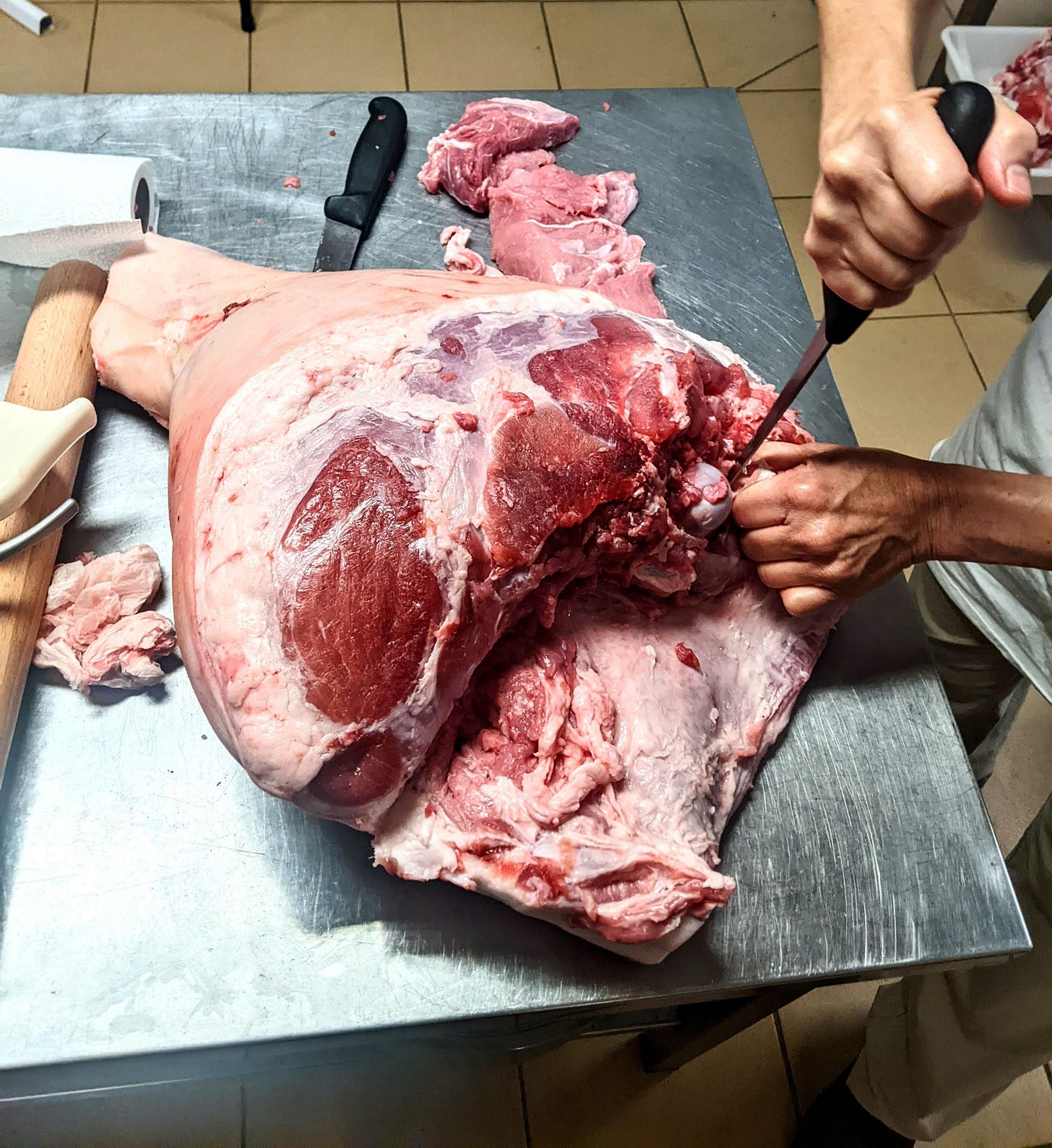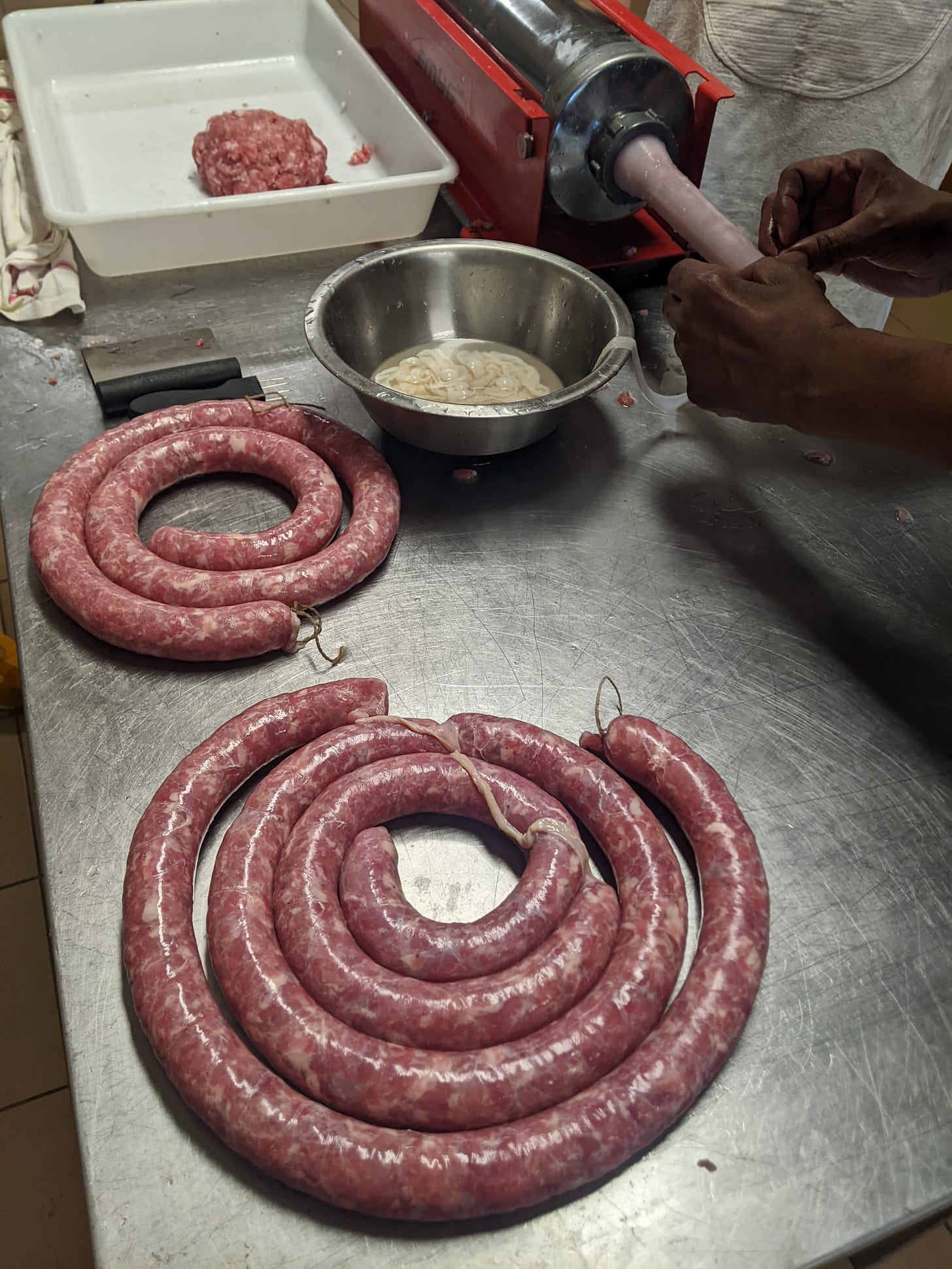We’re completely socked in here in Nérac this morning, for the third day running. The first church has just tolled nine and I have to flick on all the lamps I’ve got just to not trip over the benches shuffling around with my coffee. The second church tolls nine (always about four minutes late) and I’m trying to stay out of the way of the workmen replacing my kitchen sink window - the pea soup fog is inching in over my (now) troublesome fig tree’s leaves and through the gaping hole on my back wall. I’m a bit sore and filled with that good-tired after a successful completion of a project, without too many hiccups. All my duckies (students) are either home or en route back to their respective North American locales and I couldn’t be more proud of their work and their dedication to learning our charcuterie practices here in France.
We made a lot of stuff. Isn’t that the best? Really making stuff? Things you can touch, squeeze, monitor, and then, incredibly, taste? What a treat it is to pull off one of the smallest Noix de Jambon for us to taste together on the last day of class, and see faces light up at the punch-you-in-the-face pepperiness? To check out the trout’s belly sheen in the sunlight while you sneak another slice? To squeeze the slice and see exactly where you trimmed and shaped it?
The Meat Chandelier is over in the Old Kitchen at Camont,
’s original kitchen in France - the space is nearly perfectly suited for drying and aging products, cool, dark, and of stone and masonry. Just needs a little push with a fan to keep the air moving and keep our Noix, Coppa, Ventréche, and Saucisson happy. Each day we finished a product, we had the privilege to hang more and more pieces of charcuterie-to-be, as if we were whapping magnets atop our fifth grade report cards on the fridge. No secrets here - nowhere to hide.As part of our Practice - yeah with the capital P, like yoga Practice - we’d visit with the drying pieces and rotate them as needed, nestling new joiners in with the group, giving every one a squeeze, a sniff, ensuring that things are on the right track. What are we looking for? A too-hard crunch? Probably too much air flow. Wet spots? Pieces were probably touching each other. Crackly skin? Air pockets, most likely. A not so happy smell? Improper curing. (We didn’t have any of those, FYI.) Adjust accordingly, correct your course.
Think for a moment about how we are perceiving these pieces of charcuterie - with our hands, our sense of smell, our ears, our eyes, our tongues - we have a word for this; organoleptic perception. Using our senses in concert to perceive something that we will take into our bodies to nourish us - a bit different than zipping open a packet of sour salami from Costco, hey? That’s why you come to France - to come to the fountain and taste the genuine article — to see for yourself what things should and could be, so that you can go back home and re-create it for yourself. Not as a simulation or simulacrum, but your own, holding both things at the same time.
It’s really easy to buy cookbooks and charcuterie books. You buy them (hopefully from a local bookshop), gaze in wonder at the covers and excellent photography, flip through the foreword, and up they go onto your bookshelf. Never to be touched again. Or let’s give ourselves a little more credit, we pull them down from time to time and flip through the pages over that second cup of coffee and think about How Great It Would Be to embark on some of these projects - but life does inevitably get in the way. Out here, though, this is the life, this doing, this production, this is how you’re going to make your money - not just some romanticized version of something you’d probably be better off buying at DiLaurenti’s. (None of this is news.)
One of the most important things my mentors taught me is the importance of doing things by hand and noticing while you’re doing it. You actually have to DO it, though. That's the true thread running through all of this. I think back to my time in Panzano with Dario’s team, asking Ricci about why he would cut the rosmarino BY HAND when there was a perfectly good Robocoupe in arm’s reach. In Rome at Alice Water’s Rome Sustainable Food Project, why we would lay out every lentil we bought on sheet trays and individually pass them into the ‘good’ pile. At home on Vashon Island, when reading Paul Bertolli’s (
) Cooking by Hand, re-reading passages on his insistence on techniques that seemed incomprehensible. The breakthroughs only happen when you do it, by hand - you cut the rosemary for the Profumo di Chianti so it doesn’t smash and can dry properly; have you ever bitten down on a stone in a perfect plate of lenticchie?; trying to release Paul’s essays and recipes from the page and into practice (only sometimes successfully the first few times). How about here in France? How else do you think we make sure that the proper bloom coats each and every piece of charcuterie on the Meat Chandelier - by hand, of course.There’s so much more I will share with you all from the course - details, tips, and techniques. Tons of photos, and even a few ‘recipes’ - let’s be honest, they are methods and SOP’s. These are all well and good, and hopefully a welcome note in your inbox wherever in the world you are - but, I must insist, nothing beats the real thing. I’ve decided to offer the A Well Kept Pig workshop only once more in January 2025 until next winter (probably October 2025). So, if you’d like to come out, this is your shot.
My coffee’s gone cold and I’m in desperate need of a chocolatine.








Congratulations Nathan as another hog meets its best end under your hands.
A lovely tribute to charcuterie, and by extension, to the mastery of any field of endeavor where extensive practice and experience translates eventually into skill and wisdom. As Abraham Lincoln said: “Whatever you are, be a good one”.